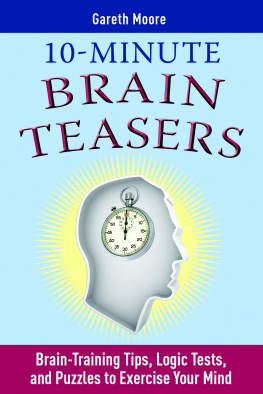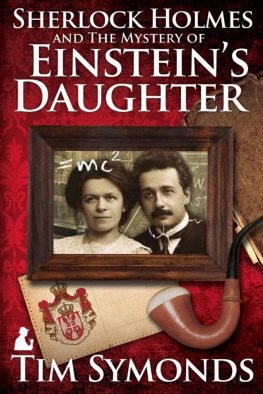Introduction
Dear Reader,
Welcome to this most portentous volume. It is the very first of its kind, for within the pages of this book I have collected together the most unique puzzle vignettes. All have been gathered during the past few years of my life, during which I have had the rare privilege to accompany that most singular of detectives, Sherlock Holmes, on many of his most renowned cases.
Should you somehow fail to have heard of the detective tour de force that is Mr. Sherlock Holmes, let me take a moment to introduce you to him, peccadillos and all.
His signature feature is his towering intellect. His cranial cogitations are majestic in their profundity, often reducing mere mortals such as you, no doubt and certainly I to mere observers, no matter how much we might wish to offer some additional insight into his investigatory activities. Having already solved a mystery, he enjoys playing with others in the way that a cat will tease its prey, ensuring that you are never in any doubt as to how superior his own intelligence is to yours. He will frequently challenge you to reach some conclusion or the other, but it is invariably one that he has long ago passed at the wayside in his own insatiable quest for knowledge.
This book collects together more than 130 such challenges that Holmes has set me over recent years, and which I present here in written form for your edification and entertainment.
These challenges are of several different types. Some rely on principles of the mathematical kind, while many need one or more logical deductions to be made from the presented writings. A few make reference to contemporary technology or other new inventions of our Victorian era, and others require abstract thinking to explain some apparently impossible situation. Let me assure you, however, that none require any special knowledge or experience, beyond the wit that God himself gave you as you entered this mortal world.
Holmes is rather fond of riddles, so I should also take this opportunity to give you fair warning that at least a few of the challenges require cleverness of the language variety, with a few plays on words and the like. If a puzzle seems unsolvable, it is always worth considering that some cleverness is at play and all is not as it seems. I have also seen fit to put a small hint into some of the puzzle titles, so if you should ever find yourself stuck it is always worth considering the true meaning of the title. It might perchance be of some small assistance in your hunt for even the most elusive of answers.
Should any of the conundrums herein happen to challenge and perplex you beyond your ken, I have (much against Holmess recommendation, I might add) included full solutions at the back of this volume. Here I have stated the answer as it was originally given to me. This section might, I suggest, be given to a friend or detective colleague to read, so that they can concoct a hint that is slightly less fiendish than those already given to you on the puzzle pages.
Each challenge may be tackled on its own, and you may dip in and out of the book at your leisure. The material tells no grand overall story, beyond documenting the genius of the man I am lucky to call my friend: Mr. Sherlock Holmes.
Doctor John Watson,
221B Baker Street, London, 1897
The First Deduction

Holmes and I met with some of the Baker Street Irregulars to discuss a case. Before we arrived at the meeting place, he remarked that we were meeting with three boys who had worked with us before: Tom, Mickey and Joe. The names rang bells, but I could not immediately remember which was which.
Which cases did they help us with again, Holmes? I asked, hoping that this would jog my memory.
Oh, let me see, Watson. It was if I remember your case names correctly The Crimson Consideration, The Mark of Three, and The Case of the Vanishing Glass.
This helped me a little, and I recalled a connection between The Mark of Three and the name Joe. But I still could not picture him, and as for the remaining two boys, I had no idea which cases they had assisted us with.
When we arrived at our meeting, I realized that I did indeed recognize all three boys. One had a mole on his chin, another a scar beneath his eye, and the third had wild, bushy hair that sprang out from his head at all angles. I was confident that the one with the scar was Mickey, as I remembered a story about his brother giving him the scar in a fight. It was then that I remembered his impressive bushy hair had featured heavily in my account of The Case of the Vanishing Glass.
From these somewhat paltry recollections, I am pleased to say I was able to greet each boy by the correct name, and make some polite remark about the case he had helped us with.
Can you deduce which name belonged to which boy, and on which case he worked?
A Special Number
Holmes once asked me, Watson, do you have a preferred number?
I thought about it for a moment, then answered, I suppose I rather like three. It has something of a pleasing quality to it.
Holmes replied with a shake of his head, before proclaiming, Where is your sense of adventure, Watson? Such a small number, and so little that can be said about it! Now tell me, what do you make of the number 8,549,176,320? It is a rather special one, if you ask me.
Indeed, it was. But why was it so special?
The Fast Train

A friend of mine works and lives in the city, but rather enjoys a jaunt to the countryside whenever possible. Each weekend, he heads off to Kings Cross station around Saturday lunchtime and catches either the train to Leicester or the train to Dover, taking whichever is leaving first. Both run at perfect twenty minute intervals, but even though the exact time of his arrival at the station is random, he has found that around 90 per cent of the time he ends up in Leicester rather than Dover.
I reported this oddity to Holmes, who was of course immediately able to shed light on it.
What was the explanation?
The Case of the Red Widow

Watson, asked Holmes, did I ever tell you about the case of the Red Widow?
No, I answered, but pray do.
It was 1879, and I had not long been in the detective business when I heard that the Earl of Buckinghamshire had been plagued by the ghostly vision of a woman. He had seen her, framed in a doorway, wearing a glowing red dress and then as he watched she melted away, fading ethereally into the whitewashed walls beyond.
Goodness, Holmes, I exclaimed. The man must have been mad. Both you and I know with perfect certainty that no inhabitant of the spectral realm has ever been proven to exist.
I assure you, dear Watson, that the man was perfectly sane. What he had seen, however, was indeed not a ghost but rather a physical manifestation planted firmly within the terra firma of our own humble existence.



















